Un cordial saludo comunidad de Foodies Bee Hive, en esta ocasión hemos preparado en casa una receta de pasta típica española, se trata de una fideuá, en este caso una fideuá serrana, pues las proteínas usadas fueron pollo y cerdo.
La fideuá es un planto de fideos, originario de la ciudad de Gandía, en España, tradicionalmente se prepara con pescados y mariscos, usando una técnica parecida a la de la paella e incluso se usa una paella o paellera, como suele llamársele en mi país, para su cocción.
En nuestro caso preparamos una fideuá serrana, pues a diferencia de la tradicional con ingredientes de marinos, usamos carnes de animales de granja, espero que sea de su agrado.
A warm greeting from the Foodies Bee Hive community, this time we have prepared at home a typical Spanish pasta recipe, it is a fideuá, in this case a fideuá serrana, because the proteins used were chicken and pork.
The fideuá is a noodle dish, originally from the city of Gandía, in Spain, traditionally prepared with fish and seafood, using a technique similar to that of paella and even using a paella or paella pan, as it is usually called in my country, for cooking.
In our case we prepared a fideuá serrana, because unlike the traditional fideuá with seafood ingredients, we use meat from farm animals, I hope you like it.
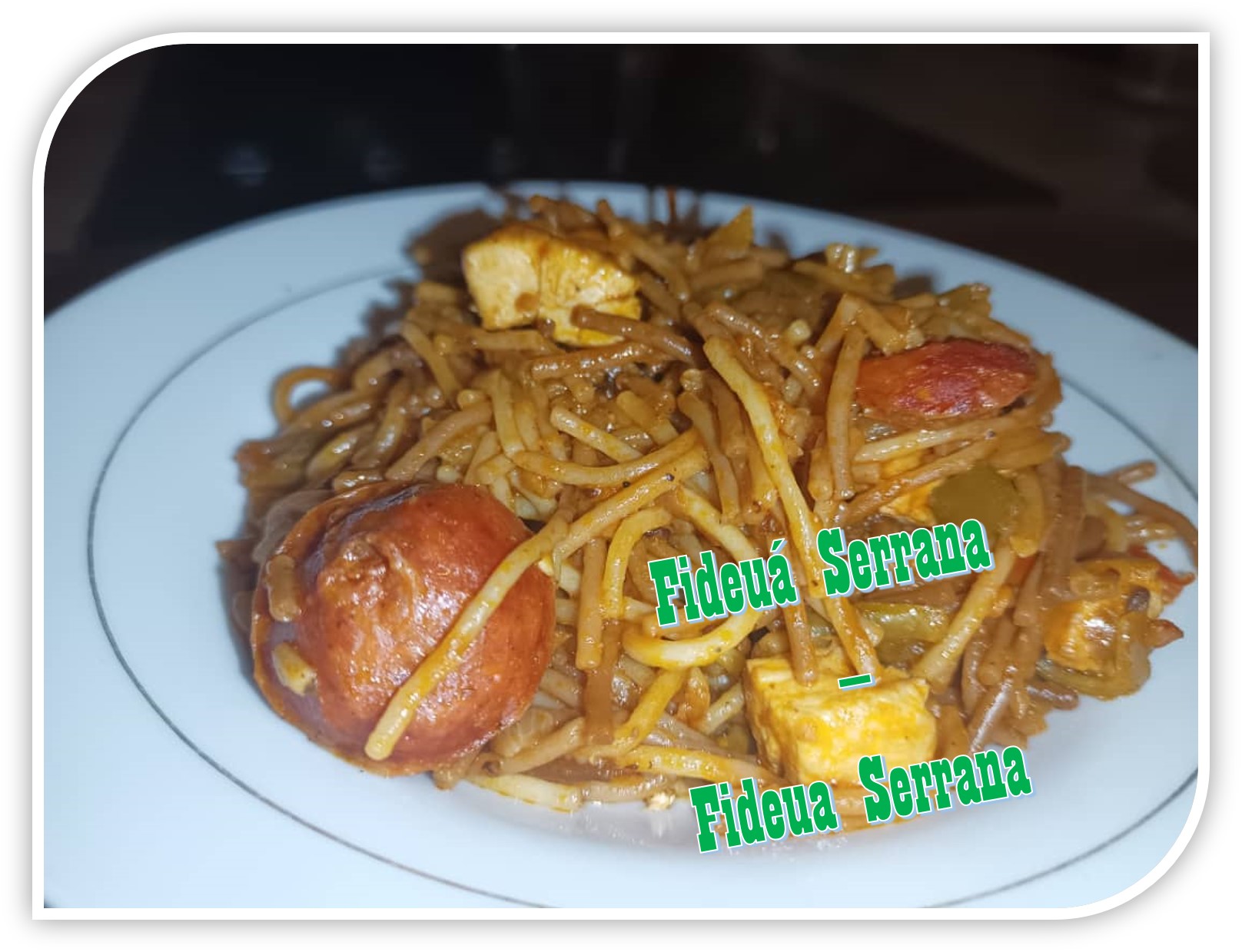

Ingredientes
Para una 3 o cuatro comensales
- 300 gramos de fideos o espaguetis troceados.
- 1/2 pechuga de pollo deshuesada.
- 2 chorizos ahumados.
- 1 pimentón mediano
- 1 cebolla mediana
- 1 o 2 ajíes dulces
- 1 o 2 tomates
- 1 taza de puré de tomate
- 1 cucharadita de onoto
- Sal, pimienta, paprika y sazonador al gusto
Ingredients
For 3 or four diners
- 300 grams of chopped noodles or spaghetti.
- 1/2 boneless chicken breast.
- 2 smoked sausages.
- 1 medium paprika.
- 1 medium onion
- 1 or 2 sweet peppers
- 1 or 2 tomatoes
- 1 cup of tomato puree
- 1 teaspoon of onoto
- Salt, pepper, paprika and seasoning to taste

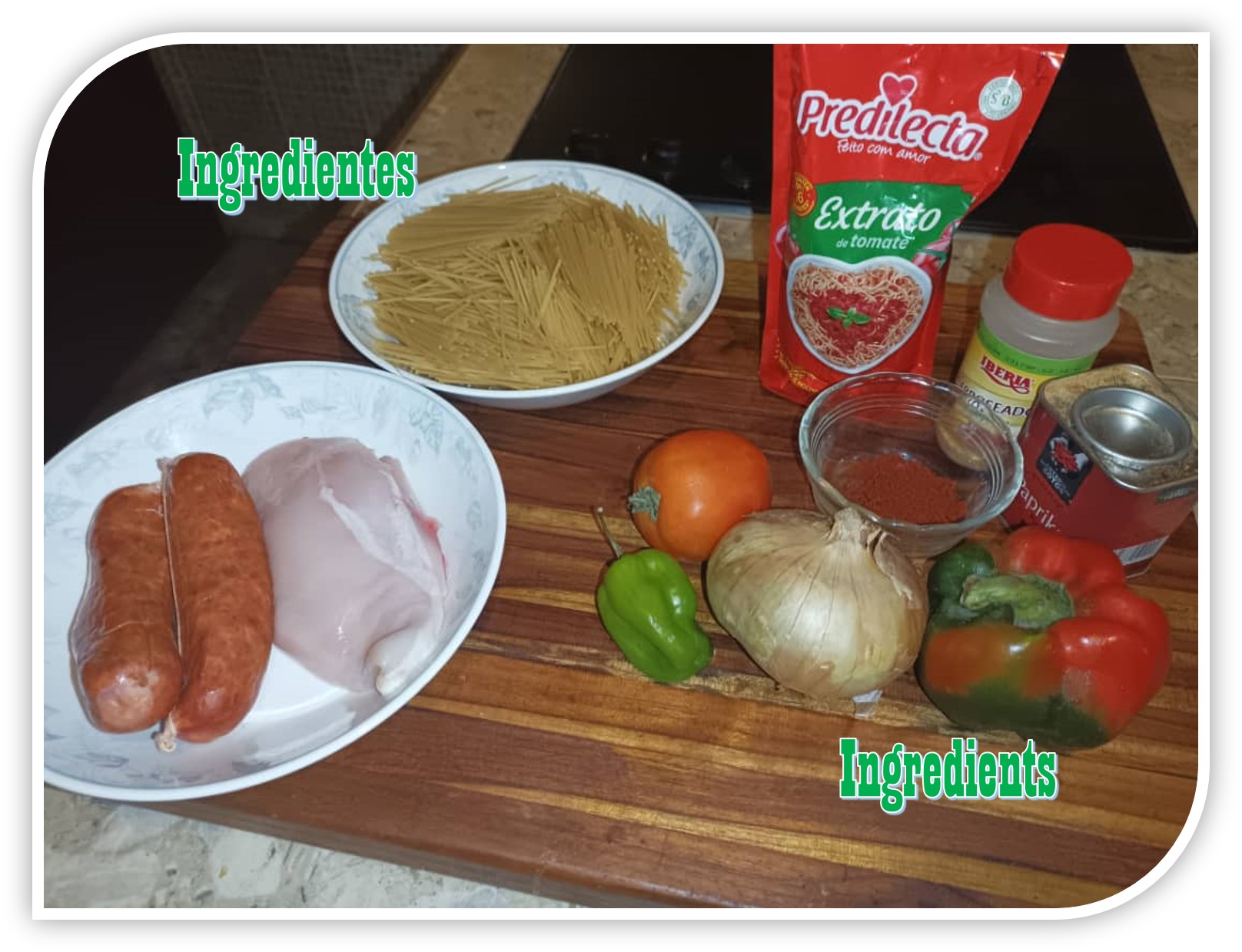

Procedimiento
Para empezar en una paellera de unos 30 cm, colocaremos una buena cantidad de aceite, preferiblemente de oliva, a calentar, suficiente como para que recubra todo el fondo del recipiente (1); en casa la paellera que tenemos es muy grande como para la cantidad que preparamos, así que usamos un caldero grande profundo y de fondo casi plano.
Cortaremos en cubos medianos el pollo y en ruedas el chorizo (2), luego pondremos a freír el chorizo hasta que quede dorado (3), luego de lo cual lo retiraremos y reservaremos (4), repetiremos el procedimiento con el pollo, el cual sazonáremos solo con un poco de sal, freiremos hasta dorar (5) y reservaremos (6).
Procedure
To begin in a paella pan of about 30 cm, we will put a good amount of oil, preferably olive oil, to heat, enough to cover the entire bottom of the pan (1); at home the paella pan we have is too big for the amount we prepare, so we use a large deep pot and almost flat bottom.
We will cut the chicken in medium-sized cubes and the chorizo (2), then we will fry the chorizo until it is golden brown (3), after which we will remove it and reserve (4), we will repeat the procedure with the chicken, which we will season only with a little salt, we will fry until golden brown (5) and we will reserve (6).

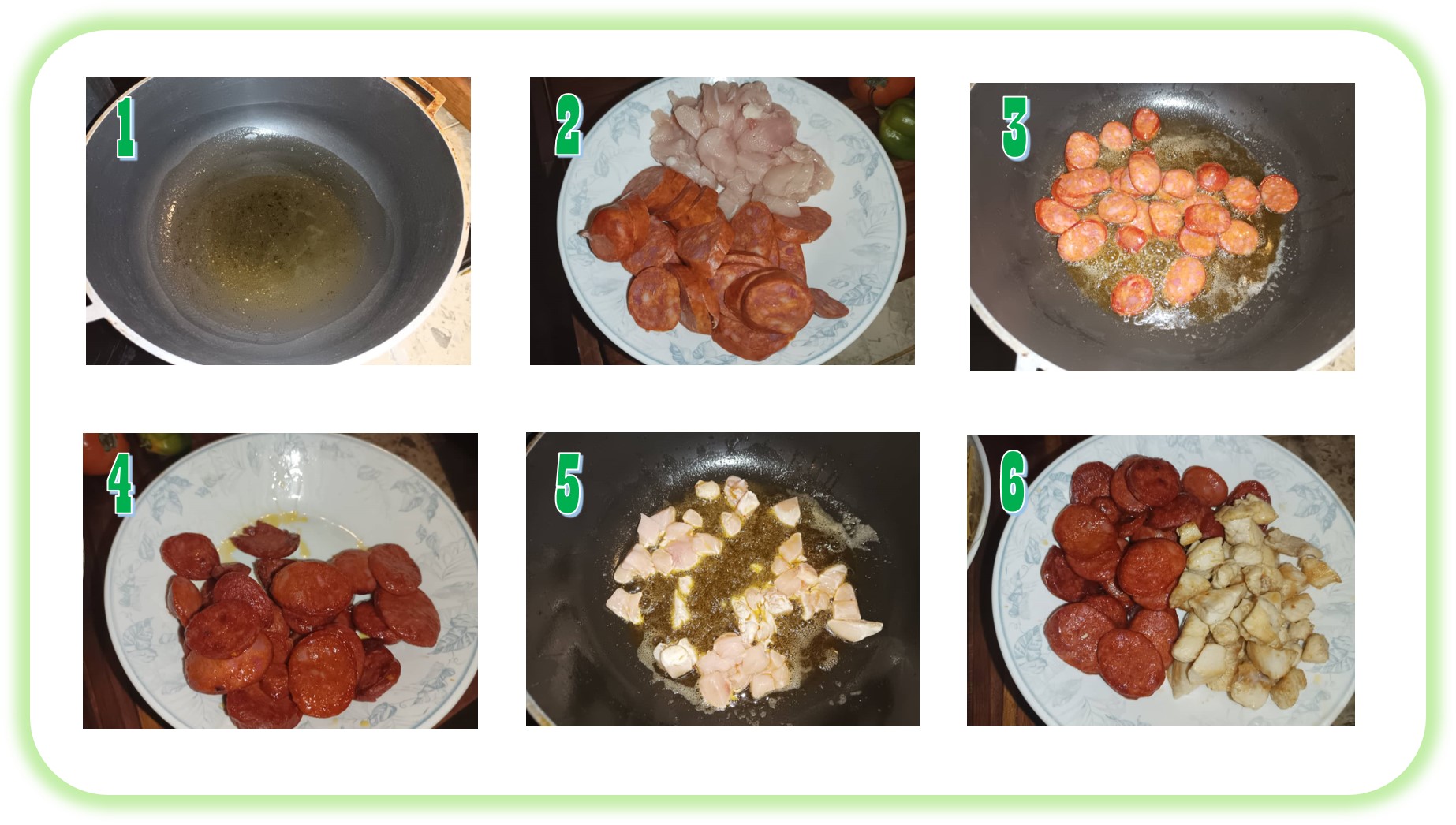

Una de las cosas que diferencia a la fideuá de la técnica clásica de preparar la pasta, tanto italiana como oriental, es que los fideos, que en nuestro caso son espaguetis partidos en trozos pequeños de cinco a siete centímetros, se tuestan en el aceite hasta dorarse, antes de cocinarse, así que los llevaremos al mismo aceite de cocción (7), y saltearemos moviendo con frecuencia para que no se quemen, hasta que se doren o tuesten un poco (8), los retiraremos del caldero o paellera y reservaremos (9).
A continuación, en el mismo aceite que hemos usado hasta ahora, saltearemos la cebolla, los ajíes, el pimentón y los tomates, cortados en cubos medianos (10), dejaremos que tomen un poco del color soltado por los chorizos sin dejar que se ablanden mucho (11) y condimentaremos con sal, pimienta, sazonador y paprika (12).
One of the things that differentiates the fideuá from the classic technique of preparing pasta, both Italian and oriental, is that the noodles, which in our case are spaghetti broken into small pieces of five to seven centimeters, are toasted in the oil until golden brown, before cooking, so we will take them to the same cooking oil (7), and we will sauté stirring frequently so that they do not burn, until they brown or toast a little (8), we will remove them from the pot or paella pan and we will reserve (9).
Next, in the same oil that we have used up to now, we will sauté the onion, the peppers, the paprika and the tomatoes, cut in medium-sized cubes (10), we will let them take a little of the color released by the chorizos without letting them get too soft (11) and we will season with salt, pepper, seasoning and paprika (12).

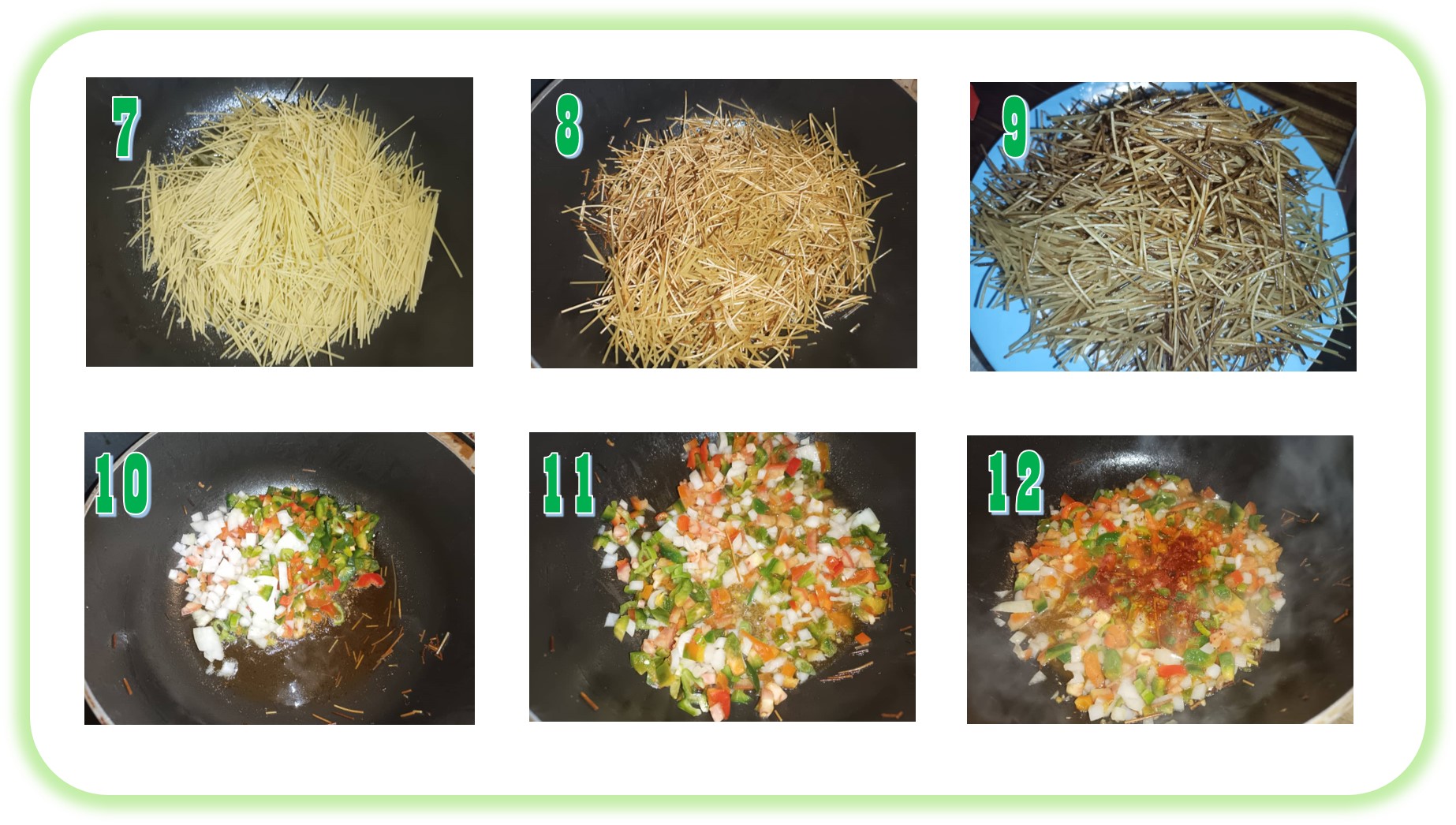

Luego de saltear por tres o cuatro minutos los vegetales, agregaremos el puré de tomates (13), el pollo y el chorizo (14) y mezclaremos, saltearemos por otros dos o tres minutos (15) y agregaremos los fideos tostados (16), revolveremos todo lo mejor posible (17) y agregaremos caldo de pollo hasta apenas cubrirlo todo (18), en nuestro caso agregamos agua y un poco de sazonador para acentuar el sabor,
cuando empiece a hervir pondremos a fuego medio bajo.
After sautéing the vegetables for three or four minutes, add the tomato puree (13), the chicken and the chorizo (14) and mix, sauté for another two or three minutes (15) and add the toasted noodles (16), stir everything as well as possible (17) and add chicken broth until it barely covers everything (18), in our case we add water and a little seasoning to accentuate the flavor, when it starts to boil we will put it over medium low heat.



Dejaremos hervir destapado para que el líquido reduzca, en la medida que la pasta se cocina (19), cuando el líquido se haya reducido en unos dos tercios, verificaremos que la pasta esté casi cocida, si lo está dejaremos que termine de reducir, si no agregaremos solo un poco más de agua o caldo y ahora si dejaremos que reduzca todo, retiraremos del fuego (20) y dejaremos reposar cubierta con papel aluminio por unos minutos, antes de servir.
Let it boil uncovered so that the liquid reduces as the pasta cooks (19), when the liquid has reduced by about two thirds, verify that the pasta is almost cooked, if it is, let it finish reducing, if not, add just a little more water or broth and now let it reduce, remove from the heat (20) and let it rest covered with aluminum foil for a few minutes before serving.



Finalmente, serviremos procurando servir a cada plato un poco de la pasta que se sobre cocina, un poco en el fondo del recipiente que queda más tostada que el resto, es lo que se llama el socarrado, y que es una parte de la paella o fideuá que suele ser muy apreciada, pues concentra los sabores de la cocción.
A diferencia de una pasta realizada por las técnicas tradicionales que suelen ser sueltas e impregnadas de salsas o cremas, la fideuá, es más melosa, siendo su textura acaramelada con un ligero sabor a tostado y ahumado y de sabores más intensos y profundos. Espero que sea de su agrado.
Finally, we will serve trying to serve to each plate a little of the pasta that is overcooked, a little in the bottom of the recipient that is more toasted than the rest, is what is called the socarrado, and that is a part of the paella or fideuá that is usually very appreciated, because it concentrates the flavors of the cooking.
Unlike a pasta made by traditional techniques that are usually loose and impregnated with sauces or creams, the fideuá, is more mellow, being its texture caramelized with a slight taste of roasted and smoked and more intense and deep flavors. I hope you like it.

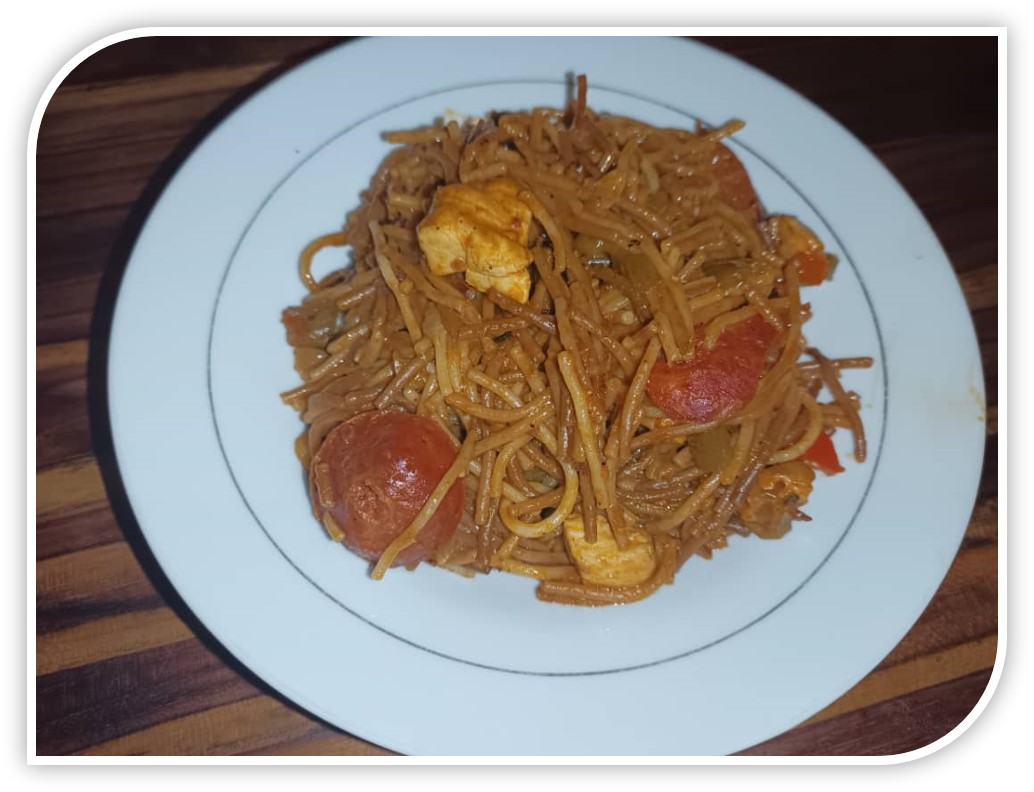



Todas las fotografías fueron tomadas con un movil Infinix Note 11 Pro
Congratulations @amart29! You have completed the following achievement on the Hive blockchain And have been rewarded with New badge(s)
Your next target is to reach 900 posts.
You can view your badges on your board and compare yourself to others in the Ranking
If you no longer want to receive notifications, reply to this comment with the word
STOPTo support your work, I also upvoted your post!
Check out our last posts:
Congratulations, your post has been upvoted by @dsc-r2cornell, which is the curating account for @R2cornell's Discord Community.
Con el apoyo de la familia.
También nos puedes apoyar en nuestro Trail de TopFiveFamily
Si desea delegar HP al proyecto de la Familia del Top Family puedes hacerlo desde aquí: Delegue 5 HP - Delegue 10 HP - Delegue 20 HP - Delegue 30 HP - Delegue 50 HP - Delegue 100 HP.
Se ve delicioso.
De hecho, lo haré hoy mismo.
Sañudos @amart29
Que esperas para unirte a nuestro trail de curación y formar parte del "proyecto CAPYBARAEXCHANGE", tu casa de cambio, rápida, confiable y segura